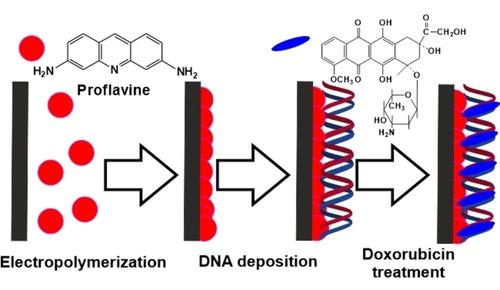当前位置:
X-MOL 学术
›
Electroanalysis
›
论文详情
Our official English website, www.x-mol.net, welcomes your feedback! (Note: you will need to create a separate account there.)
Impedimetric DNA Sensor Based on Poly(proflavine) for Determination of Anthracycline Drugs
Electroanalysis ( IF 3 ) Pub Date : 2020-01-08 , DOI: 10.1002/elan.201900653 Anna V. Porfireva 1 , Anastasia I. Goida 1 , Alexey M. Rogov 2 , Gennady A. Evtugyn 1
Electroanalysis ( IF 3 ) Pub Date : 2020-01-08 , DOI: 10.1002/elan.201900653 Anna V. Porfireva 1 , Anastasia I. Goida 1 , Alexey M. Rogov 2 , Gennady A. Evtugyn 1
Affiliation

|
Electropolymerization is often used as a tool for immobilization of charged biopolymers and their electric wiring in the biosensor assembly. In this work, electropolymerization of proflavine has been for the first time used for the physical adsorption of DNA and measurement of anthracycline drugs (doxorubicin and daunorubicin) able to intercalate DNA. Redox properties of the proflavine polymers on the glassy carbon electrode and DNA deposition were characterized with cyclic voltammetry, scanning electron microscopy and electrochemical impedance spectroscopy. It was shown that DNA decreased the peak currents on voltammogram but increased the charge transfer resistance. The latter effect is pronounced with the following drug application. The impedimetric response regularly increased with the drugs concentration in the range 1 nM to 0.1 μM for doxorubicin and 1 pM–10 nM for daunorubicin (limit of detections 0.3 and 0.001 nM, respectively). The biosensor was tested on pharmaceutical preparations and spiked solution simulating the plasma electrolytes and possible interference of serum proteins.
中文翻译:

基于聚(黄酮)的阻抗式DNA传感器用于蒽环类药物的测定
电聚合通常被用作将带电的生物聚合物及其电线固定在生物传感器组件中的工具。在这项工作中,前黄素的电聚合首次用于物理吸附DNA和测量能够插入DNA的蒽环类药物(阿霉素和柔红霉素)。用循环伏安法,扫描电子显微镜和电化学阻抗谱对原黄酮聚合物在玻璃碳电极上的氧化还原特性和DNA沉积进行了表征。结果表明,DNA降低了伏安图上的峰值电流,但增加了电荷转移电阻。后一药效明显。当药物浓度在1 nM至0范围内时,阻抗反应通常会增加。阿霉素为1μM,柔红霉素为1 pM-10 nM(检出限分别为0.3和0.001 nM)。该生物传感器在药物制剂和加标溶液中进行了测试,以模拟血浆电解质和血清蛋白的可能干扰。
更新日期:2020-01-08
中文翻译:

基于聚(黄酮)的阻抗式DNA传感器用于蒽环类药物的测定
电聚合通常被用作将带电的生物聚合物及其电线固定在生物传感器组件中的工具。在这项工作中,前黄素的电聚合首次用于物理吸附DNA和测量能够插入DNA的蒽环类药物(阿霉素和柔红霉素)。用循环伏安法,扫描电子显微镜和电化学阻抗谱对原黄酮聚合物在玻璃碳电极上的氧化还原特性和DNA沉积进行了表征。结果表明,DNA降低了伏安图上的峰值电流,但增加了电荷转移电阻。后一药效明显。当药物浓度在1 nM至0范围内时,阻抗反应通常会增加。阿霉素为1μM,柔红霉素为1 pM-10 nM(检出限分别为0.3和0.001 nM)。该生物传感器在药物制剂和加标溶液中进行了测试,以模拟血浆电解质和血清蛋白的可能干扰。

























 京公网安备 11010802027423号
京公网安备 11010802027423号